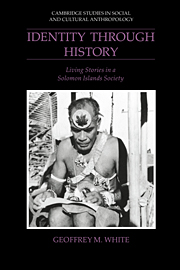Book contents
- Frontmatter
- Contents
- List of illustrations
- Preface
- Acknowledgments
- Orthography
- 1 Introduction
- I ORIENTING
- II TRANSFORMING
- III NARRATING
- IV REVITALIZING
- 9 Collisions and convergence
- 10 The paramount chief: rites of renewal
- 11 Conclusion
- Notes
- References
- Index
- Cambridge Studies in Social and Cultural Anthropology
9 - Collisions and convergence
Published online by Cambridge University Press: 12 January 2010
- Frontmatter
- Contents
- List of illustrations
- Preface
- Acknowledgments
- Orthography
- 1 Introduction
- I ORIENTING
- II TRANSFORMING
- III NARRATING
- IV REVITALIZING
- 9 Collisions and convergence
- 10 The paramount chief: rites of renewal
- 11 Conclusion
- Notes
- References
- Index
- Cambridge Studies in Social and Cultural Anthropology
Summary
The Christianization of Santa Isabel transformed the fabric of social and political life at the same time as it introduced new religious practices. Much of this was accomplished through new types of big-men working within the mission sphere, including Christian chiefs, catechists and priests. Into this emergent Christian society with its village-based communities, Christian chiefs and chiefly catechists came a new presence: government. Beginning with the incorporation of Santa Isabel within the sphere of the British Solomon Islands Protectorate in 1899, and accelerating with the establishment of a government office on the island in 1918, the colonial administration based at Tulagi in neighboring Nggela became an increasingly intrusive force in local affairs.
Here, as with missionization, the government presence was felt through the agency of local leaders: at first government-appointed chiefs and then headmen, councilors and, today, “members” of the provincial assembly. Through all of this, the “chief” remained a central figure even as the field of power and meaning in village life was increasingly differentiated by processes of colonization and Christianization. In their former roles as feastgiver, alliance-maker and warrior, chiefs had mediated relations among localized followings, personifying the vitality and integrity of their regions. It was perhaps inevitable, then, that chiefs would become the focus for indigenous efforts at managing the exogenous forces of change – efforts that are evident in a series of attempts to redefine and readjust sociopolitical realities.
- Type
- Chapter
- Information
- Identity through HistoryLiving Stories in a Solomon Islands Society, pp. 183 - 208Publisher: Cambridge University PressPrint publication year: 1991



